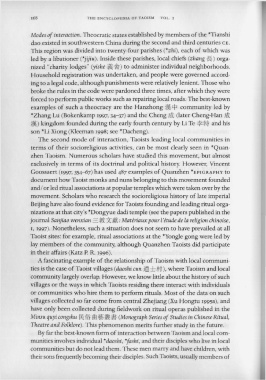Page 208 - The Encyclopedia of Taoism v1_A-L
P. 208
168 THE ENCYCLOPE DIA OF TAOISM VOL. T
Modes of interaction. Theocratic states established by members of the *Tianshi
dao existed in southwestern China during the second and third centuries CE.
This region was divided into twenty-four parishes (*zhi), each of which was
led by a libationer (*jijiu). Inside these parishes, local chiefs (zhang -&) orga-
nized "charity lodges" (yishe i'/lj11f) to administer individual neighborhoods.
Household registration was undertaken, and people were governed accord-
ing to a legal code, although punishments were relatively lenient. Those who
broke the rules in the code were pardoned three times, after which they were
forced to perform public works such as repairing local roads. The best-known
examples of such a theocracy are the Hanzhong yJ J:j:t community led by
*Zhang Lu (Bokenkamp 1997, 34-37) and the Cheng !VG (later Cheng-Han !VG
11D kingdom founded during the early fourth century by Li Te *!M= and his
son *Li Xiong (Kleeman 1998; see *Dacheng).
The second mode of interaction, Taoists leading local communities in
terms of their socioreligious activities, can be most clearly seen in *Quan-
zhen Taoism. Numerous scholars have studied this movement, but almost
exclusively in terms of its doctrinal and political history. However, Vincent
Goossaert (1997, 354- 67) has used 487 examples of Quanzhen *EPIGRAPHY to
document how Taoist monks and nuns belonging to this movement founded
and/ or led ritual associations at popular temples which were taken over by the
movement. Scholars who research the socioreligious history of late imperial
Beijing have also found evidence for Taoists founding and leading ritual orga-
nizations at that city's *Dongyue dadi temple (see the papers published in the
journal Sanjiao wenxian = t-il:)J:..fA: Materiaux pour l' etude de la religion chinoise,
I, 1997). Nonetheless, such a situation does not seem to have prevailed at all
Taoist sites: for example, ritual associations at the *Yongle gong were led by
lay members of the community, although Quanzhen Taoists did participate
in their affairs (Katz P. R. 1996).
A fascinating example of the relationship of Taoism with local communi-
ties is the case of Taoist villages (daoshi run J!! ± if'J), where Taoism and local
community largely overlap. However, we know little about the history of such
villages or the ways in which Taoists residing there interact with individuals
or communities who hire them to perform rituals. Most of the data on such
villages collected so far come from central Zhejiang (Xu Hongtu 1995a), and
have only been collected during fieldwork on ritual operas published in the
Minsu quyi congshu ~ {~ illl ~ i'ii ~ (Monograph Series of Studies in Chinese Ritual,
Theatre and Folklore). This phenomenon merits further study in the future.
By far the best-known form of interaction between Taoism and local com-
munities involves individual *daoshi, *fashi, and their di ciples who live in local
communities but do not lead them. These men marry and have children, with
their sons frequently becoming their disciples. Such Taoists, usually members of

